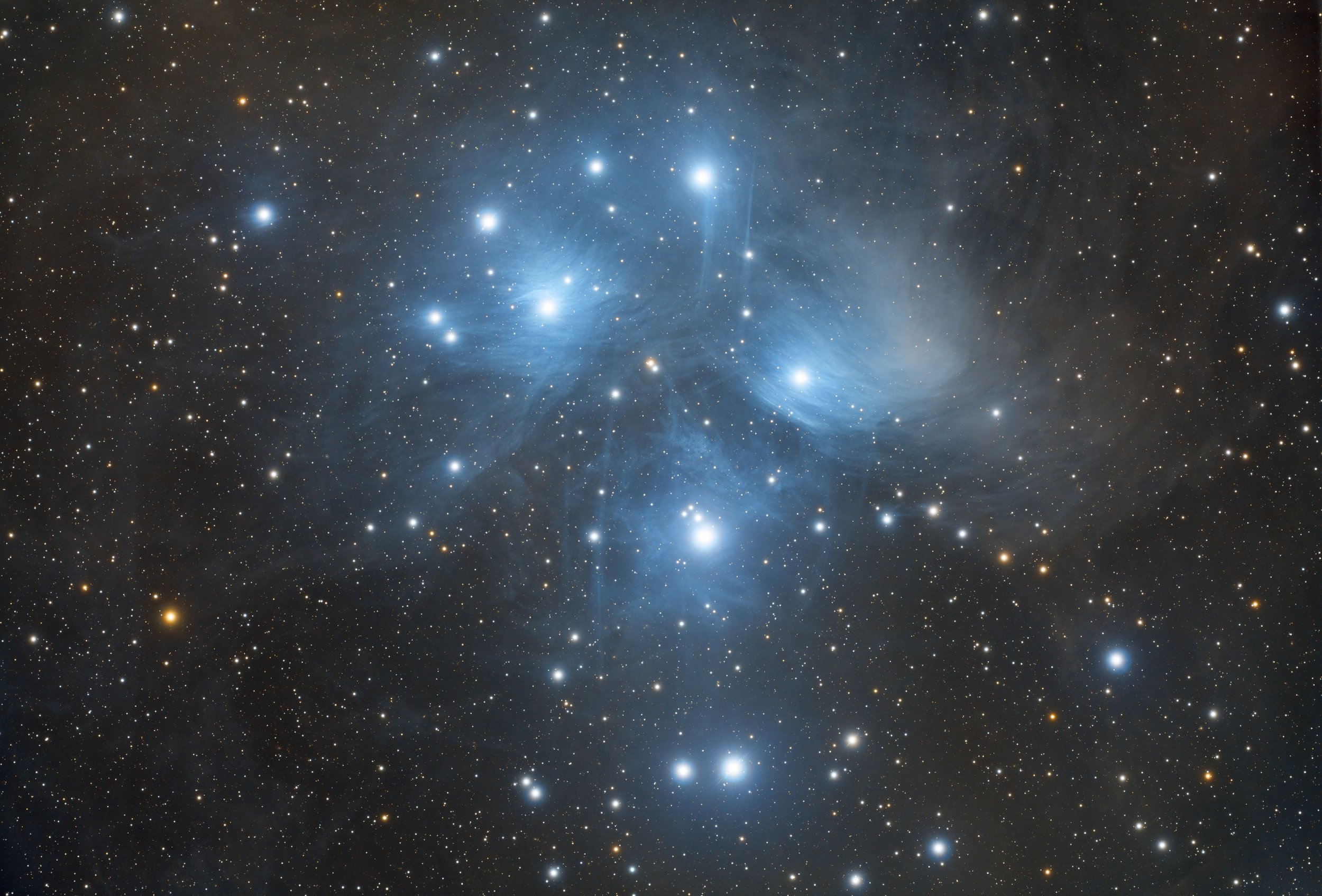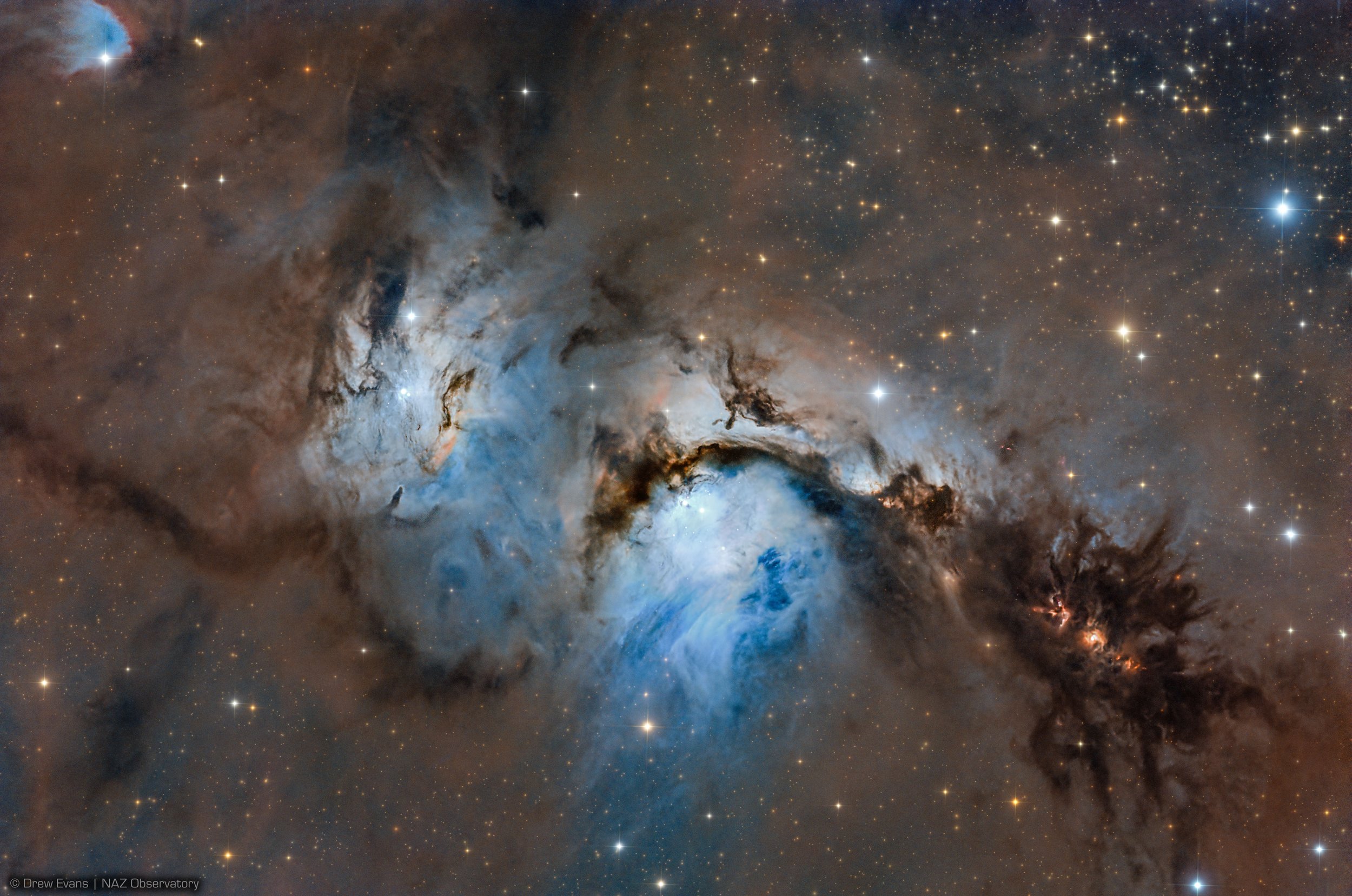
AAPOD2 Image Archives
Integrated Flux Nebula
The Integrated Flux Nebula (IFN) is a subtle yet captivating phenomenon that stretches across the night sky, revealing itself as a faint glow in deep-sky astrophotography. Unlike traditional emission or reflection nebulae, the IFN does not emit its own light nor reflect light from nearby stars. Instead, it consists of dust particles scattering and reflecting the light of distant stars, giving rise to a diffuse luminosity that pervades large regions of space.
Named for its integrated flux of scattered starlight, the IFN is often found in regions with relatively low levels of interstellar dust, allowing the faint glow to become visible against the backdrop of the Milky Way. Its presence highlights the vast expanses of dust and gas that permeate our galaxy, serving as a testament to the intricate interplay between stars, dust, and the cosmic environment. Despite its elusive nature, the IFN offers astronomers valuable insights into the distribution of interstellar material and the dynamics of starlight scattering throughout the Milky Way.
LDN 1622 (Bogeyman Nebula) HaLRGB
LDN 1622, famously dubbed the Bogeyman Nebula, presents a captivating celestial spectacle nestled within the constellation Orion. This dark nebula, shrouded in cosmic dust and gas, creates a mysterious and eerie silhouette against the backdrop of the Milky Way. Resembling the mythical figure of the Bogeyman, it evokes a sense of intrigue and wonder among stargazers and astronomers.
Photographed in a combination of hydrogen-alpha (Ha) and RGB filters, this image reveals the intricate details of LDN 1622's structure and surroundings. The HaLRGB composition captures the interplay between light and shadow, showcasing the subtle glow of ionized hydrogen gas amidst the dark tendrils of dust. Such intricate features offer valuable insights into the processes of star formation and interstellar matter within this enigmatic region of space.
Studying LDN 1622 provides astronomers with a window into the complex dynamics of molecular clouds and the birth of new stars. By unraveling the mysteries of this cosmic bogeyman, scientists deepen their understanding of the fundamental processes shaping the evolution of galaxies and the universe at large.
The Southern Pinwheel Galaxy (M83)
The Southern Pinwheel Galaxy, also known as Messier 83 or M83, is a striking barred spiral galaxy located in the constellation Hydra. Situated approximately 15 million light-years away from Earth, M83 is one of the closest and brightest spiral galaxies visible from the Southern Hemisphere. Its distinctive spiral arms, adorned with bright clusters of young stars and nebulae, make it a captivating subject for astronomers and astrophotographers alike.
M83 is a hotbed of stellar activity, with ongoing star formation occurring within its spiral arms. It is home to numerous star clusters, nebulae, and regions of intense starbirth, indicating a vigorous cycle of stellar birth and death. Studying M83 provides astronomers with valuable insights into the processes driving galaxy evolution and the formation of stars. Additionally, M83 has been the site of several supernova explosions, further adding to its allure for astronomers seeking to understand the life cycles of stars and galaxies.
NGC 4216 and Friends
NGC 4216, nestled within the constellation of Virgo, is a beautiful barred spiral galaxy situated about 40 million light-years away from Earth. It is part of the vast Virgo Cluster, a rich gathering of galaxies bound together by gravity. In this cosmic neighborhood, NGC 4216 is not alone; it shares its celestial surroundings with a host of neighboring galaxies, forming a captivating ensemble of cosmic companions.
Among its companions are several other galaxies, each with its own unique features and characteristics. These celestial neighbors contribute to the rich tapestry of the Virgo Cluster, offering astronomers valuable opportunities to study the dynamics and interactions within this galactic community. By observing NGC 4216 and its companions, scientists can unravel the complex processes shaping the evolution of galaxies and gain deeper insights into the vast cosmic web of which we are a part.
Trunk Nebula
The Trunk Nebula, formally known as IC 1396A, is a striking emission nebula located within the larger star-forming region IC 1396 in the constellation of Cepheus. Aptly named for its resemblance to an elephant's trunk, this nebula exhibits a distinctive elongated shape with a dark, winding lane of dust and gas. At its tip lies a cluster of young, massive stars that illuminate the surrounding nebular material, causing it to glow with vivid colors.
IC 1396A offers astronomers a fascinating glimpse into the processes of star birth and evolution. Within its dense clouds of gas and dust, new stars are forming, surrounded by glowing regions of ionized hydrogen. These stellar nurseries provide valuable insights into the mechanisms driving star formation and the dynamics of interstellar matter. Additionally, the Trunk Nebula serves as a captivating example of the intricate structures found throughout the cosmos, inspiring wonder and curiosity about the mysteries of the universe.
Hydrogen Mountains - BBW 56
BBW 56, also known as Barnard 56, is a dark nebula located in the constellation Ophiuchus. Dark nebulae like BBW 56 are dense clouds of dust and gas that obscure the light of stars behind them, creating striking silhouettes against the backdrop of the Milky Way. BBW 56 appears as a prominent dark patch against the starry sky, characterized by its intricate tendrils and filaments.
This dark nebula serves as a reminder of the vast and complex structures present in our galaxy, highlighting the interplay between light and shadow in the cosmos. While dark nebulae may appear devoid of light, they play a crucial role in the formation of stars and planetary systems, acting as the birthplaces of new celestial objects. By studying dark nebulae like BBW 56, astronomers gain valuable insights into the processes of star formation and the evolution of galaxies, deepening our understanding of the universe's rich tapestry.
A 152h Deep Exploration of the Carina Nebula and its Surroundings in High Resolution
The Carina Nebula, a sprawling cosmic vista nestled in the southern skies, stands as one of the most magnificent star-forming regions in our galaxy. Located in the constellation Carina, this celestial masterpiece spans over 300 light-years across, teeming with vibrant clouds of gas and dust illuminated by the intense radiation from young, massive stars. At the heart of the nebula lies Eta Carinae, a stellar behemoth prone to violent outbursts, and a cluster of brilliant stars known as the Trumpler 14 and Trumpler 16 clusters. The intricate filaments and pillars within the Carina Nebula, sculpted by the forces of stellar winds and radiation pressure, evoke a sense of cosmic grandeur and wonder.
As one of the largest and most luminous nebulae in the night sky, the Carina Nebula serves as a natural laboratory for studying the processes of star formation and stellar evolution. Within its sprawling expanse, we uncover the secrets of how massive stars shape their surroundings, triggering the birth of new stars and sculpting the landscape of the cosmos. From its dazzling star clusters to its ethereal tendrils of gas and dust, the Carina Nebula stands as a testament to the beauty and complexity of the universe, inviting us to explore and unravel its mysteries.
M78 (NGC 2068)
M78, a reflection nebula situated in the constellation of Orion, captivates us with its ethereal beauty and celestial significance. Located approximately 1,600 light-years away from Earth, this nebula is illuminated by the light of young, hot stars embedded within its dusty embrace. Its distinctive bluish glow emanates from the scattering of starlight by interstellar dust grains, creating a mesmerizing spectacle against the dark backdrop of space.
M78 is a prominent member of the Orion Molecular Cloud Complex, a vast region of gas and dust where new stars are born. Within its wispy tendrils lie stellar nurseries, where dense clouds of gas collapse under their own gravity to form newborn stars. M78 serves as a celestial laboratory, offering us valuable insights into the processes of star formation and the interplay between young stars and their natal environments. As a beacon of cosmic evolution, M78 continues to inspire exploration and discovery, inviting us to peer into the depths of the universe and unravel its mysteries.










